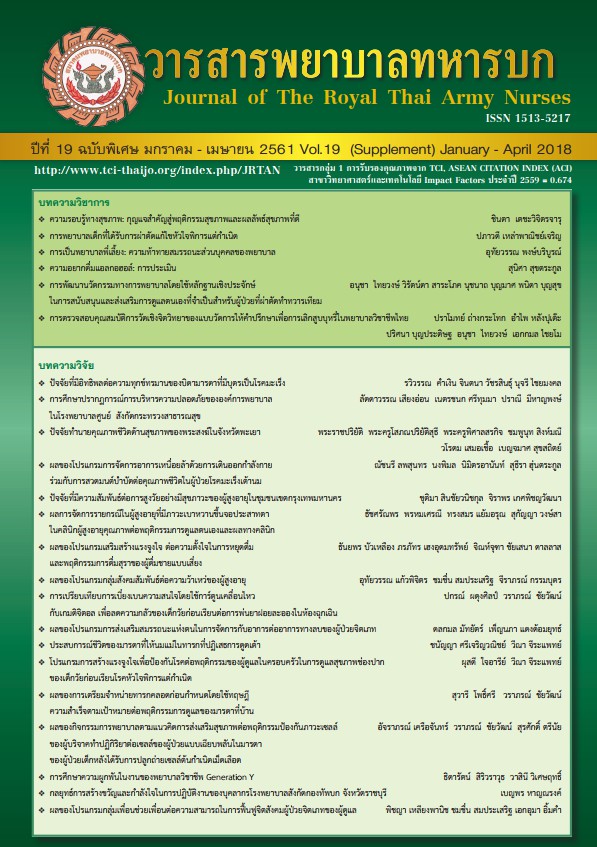The Confirmatory Factor Analysis of Nursing Students’ Caring Characteristics
Keywords:
Confirmatory factor analysis, Caring Characteristics, Nursing StudentsAbstract
The purpose of this research was to examine how well the empirical data fit the nursing students’ caring characteristic model. Data were collected from 411 third year and fourth- year nursing students during the academic year 2018 at threes government nursing educational institutes by using a 67 item self-report questionnaire Measuring caring characteristics with 1-5 rating scale. The questionnaire was tested for content validity by five experts and revealed the item objective congruence (IOC) between .60 and 1.00, item discrimination (r.) between .208 and .565 and the reliability (α) of .941. The data were analyzed with confirmatory factor analysis. The results revealed that the caring characteristics among nursing students consisted of seven main factors: 1. Understanding of human value and kindness 2. Instillation of faith-hope 3. Cultivation of sensitivity to one’s self feeling and to others 4. Establishing a helping relationship 5. Learning promotion 6. Provision for a supportive, protective, and or corrective mental, physical, societal, and spiritual environment 7. Assistance with gratification of human needs. Each of these indicators was consistent with the empirical data: χ2 = 15.99; p-value = .067; GFI = .989; AGFI = .967; NFI = .994; RMSEA = .049; RMR = .002; SRMR = .01; P-Value for Test of Close Fit = 1.00; CFI = .997. The standard weight of each main factor was between .78 and .95
Downloads
References
2. Fly, S.T. Ethics in Nursing Practice: A Guide to Ethical Decision Making. Geneve: The International Council of Nurse. New Jersey: Wiley-Blackwel; 2008.
3. Kittiboonthawal P, Chuencharm J, Korjedee P, Sondee K, Singpraphai P. Opinions of Nursing students, Nursing Faculty, and Clients on Humanized Community Care Nursing Practicum and Its Relate Factors. Journal of Nursing Education. 2013; 6(1): 69-79. (in Thai)
4. Watson J. Nursing: The philosophy and science of caring. Nursing administration quarterly. 1979 Jul 1; 3(4): 86-87.
5. Qiuting CA. Humanistic caring: the core of nursing. Journal of Medical Colleges of PLA. 2013 Apr 1; 28(2): 125-128.
6. Sirisom K, Wanwilai P, Kaewmahakal O. Nursing Care Behaviors of Nursing Students While practicing nursing practice individuals with health problems According to their own perception,Teachers and Service recipients. Songkhla: Praboromarajchanok Institute Office for Health Workforce Development,
Office of the Permanent Secretary, Ministry of Public Health. 2008. (in Thai)
7. Khademian Z, Vizeshfar F. Nursing students’ Percetions of the importance of caring behaviors. Journal compilation. 2007; 456-460.
8. Bundasak T, SoSome B, Chaowiang K, Jungasem N, Thiankumsri K, Sittisongkram S. Being Learners in 21st Century: Teacher and Nursing
Students’ Perspectives. Journal of MCU Peace Studies. 2016; 4(2): 175-189. (in Thai)
9. Chaiyasit Y, Chaila K, Unlah H, Aripan P, Khanawong R, Sangtong C, et al. Nursing Student’s Perceptions of Caring Behaviors in Boromarajonani College of Nursing, Nakhon Phanom. Journal of Nursing Science & Health. 2013; 36(2): 86-94. (in Thai)
10. Smith MC, Parker ME. Nursing theories and nursing practice. FA Davis; 2015 Feb 3.
11. Iamsamai S. The Development of Instructional Model for Caring Behavioral Promotion in Bachelor of Nursing Science Program at Borromarajonani Praputthabat Nursing Colledge. Journal of Education Khon Kaen University. 2010; 33(4): 131-9. (in Thai)
12. Suebwonglee C, Sijiva S, Vongvanich S. Development of a Nursing Caring Behavior Assessment Instrument using the Cognitive Interview Technique. SDU Research. 2011; 7(2): 127-142. (in Thai)
13. Watson J. Nursing: The philosophy and science of caring. Nursing administration quarterly. 1979 Jul 1; 3(4): 86-87.
14. Tabachnick BG, Fidell LS. Using multivariate statistics. 5th ed. Washington, DC: Allyn & Bacon/Pearson Education; 2007.
15. VanVoorhis CW, Morgan BL. Understanding power and rules of thumb for determining sample sizes. Tutorials in Quantitative Methods for Psychology. 2007; 3(2): 43-50.
16. Srisatitnaragool B. Development and validation of research tools: Qualitative Measurement. Bangkok, Printing of Chulalongkorn University; 2012. (in Thai)
17. Cronbach, Lee Joseph. Essentials of Psychological Tesing. 4th ed. New York: Harperand Row; 1990.
18. Pallant, J. SPSS Survival Manual. A Step by Step Guide to Data Analysis Using the SPSS Program 5th ed. Maidenhead, Berkshire, England:
Mc Graw-Hill; 2013.
19. Likert R. A technique for the measurement of attitudes. Archives of psychology. 1932; 22(140): 55.
20. Panpharean S, Sirikul S. Caring Behaviors of Nursing students in Clinical Nursing Practice. Journal of Nursing and Education. 2012; 3(3): 64-74. (in Thai)
21. Roach MS, Canadian Hospital Association. The Human Act of Caring A Blueprint for the Health Professions; 1987.
22. Wade, GH, Kasper, N. Nursing students’ perceptions of instructor caring: An instrument based on Watson’s theory of transpersonal caring. Journal of Nursing Education. 2006; 45(5): 162-168.
23. Boonprasert W, Cheevakasemsook A, Kusolvisitkul W. Development of nursing care service model of nursing profession in pediatric patients in Chiang Kham Hospital. The 3rd STOU Graduate Research Conference; 2013. (in Thai)
24. Leaungsomnapa Y, Timsuwan B, Promproh S. Analysis of nursing care components of nursing instructors. Journal of Phrapokklao Nursing College. 2551; 21(2). 1-15. (in Thai)
25. Dewar B, Nolan M. Caring about caring: developing a model to implement compassionate relationship centred care in an older people care setting. International Journal of Nursing Studies. 2013; 50(9): 47-58.
26. Williams RL, McDowell JB, Kautz DD. A caring leadership model for nursing’s future. International Journal for Human Caring. 2011; 15(1): 31.
27. Prasrertsong C, Benjamin A, Wanfun P. The Study to Confirm and Develop the Measure of Nursing Practice by Heart for Nursing Students.
Journal of The Royal Thai Army Nurses. 2016; 17(3): 132-140. (in Thai)
Downloads
Published
How to Cite
Issue
Section
License
บทความหรือข้อคิดเห็นใดใดที่ปรากฏในวารสารพยาบาลทหารบกเป็นวรรณกรรมของผู้เขียน ซึ่งบรรณาธิการหรือสมาคมพยาบาลทหารบก ไม่จำเป็นต้องเห็นด้วย
บทความที่ได้รับการตีพิมพ์เป็นลิขสิทธิ์ของวารสารพยาบาลทหารบก
The ideas and opinions expressed in the Journal of The Royal Thai Army Nurses are those of the authors and not necessarily those
of the editor or Royal Thai Army Nurses Association.






